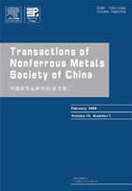Phase classification of high entropy alloys with composition, common physical, elemental-property descriptors and periodic table representation
(1. School of Materials Science and Chemical Engineering, Harbin University of Science and Technology, Harbin 150080, China;
2. School of Computer Science and Technology, Harbin University of Science and Technology, Harbin 150080, China;
3. Key Laboratory of Engineering Dielectric and Applications (Ministry of Education), School of Electrical and Electronic Engineering, Harbin University of Science and Technology, Harbin 150080, China)
2. School of Computer Science and Technology, Harbin University of Science and Technology, Harbin 150080, China;
3. Key Laboratory of Engineering Dielectric and Applications (Ministry of Education), School of Electrical and Electronic Engineering, Harbin University of Science and Technology, Harbin 150080, China)
Abstract: Phase classification has a clear guiding significance for the design of high entropy alloys. For mutually exclusive and non-mutually exclusive classifications, the composition descriptors, commonly used physical parameter descriptors, elemental-property descriptors, and descriptors extracted from the periodic table representation (PTR) by the convolutional neural network were collected. Appropriate selection among features with rich information is helpful for phase classification. Based on random forest, the accuracy of the four-label classification and balanced accuracy of the five-label classification were improved to be 0.907 and 0.876, respectively. The roles of the four important features were summarized by interpretability analysis, and a new important feature was found. The model extrapolation ability and the influence of Mo were demonstrated by phase prediction in (CoFeNiMn)1-xMox. The phase information is helpful for the hardness prediction, the classification results were coupled with the PTR of hardness data, and the prediction error (the root mean square error) was reduced to 56.69.
Key words: high entropy alloy; phase classification; feature engineering; periodic table representation; convolutional neural network; hardness prediction

